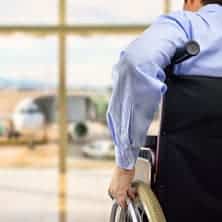 A great article in International Airport Review recently highlighted the definition of Passengers with Restricted Mobility (PRM) and their rights.
A great article in International Airport Review recently highlighted the definition of Passengers with Restricted Mobility (PRM) and their rights.
As a number of our past and current projects have looked in depth at the journey of PRMs throughout an airport, and how they must be considered when looking at capacity and passenger flow, we found this to be an illuminating insight.
The article stated that “PRMs or Passengers with Restricted Mobility represent one of the fastest-growing demographics in aviation with annual growth in passenger numbers often at least six times that of the overall rate of passenger growth at many global airports.” 1.2 million PRMs travelled through Heathrow alone in 2016, a staggering indication of the volumes of traffic they represent.
What defines a PRM?
PRMs are defined as those that have difficulty walking long distances and/or up stairs, and those who are immobile. The definition of these passengers, how they travel through an airport and the difficulties they face, is something AiQ have analysed and simulated in great detail. The data we use in our simulations conveys typical human behaviour in all passengers, whether they are PRM or not, travelling through an airport terminal. This is what we refer to as ‘full human physics behaviour’.
It’s essential that all PRMs, Airport Operators and Airlines know the rights of this group when they travel by air. The article from International Airport Review quotes the The Civil Aviation Authority and its simple written explanation on the rights held by PRMs in the UK:
“If you’re a passenger with a disability or reduced mobility you are legally entitled to support, commonly known as ‘Special Assistance’, when travelling by air.”
Airports and airlines must provide free help and assistance to ensure a less stressful journey. Special assistance must also be made available to other passengers that may require it, such as “the elderly, those people with a physical disability, such as wheelchair users, and those who have difficulty with social interaction and communication, such as those with autism or dementia.”
Considering PRMs within Terminals
Making sure that this ‘Special Assistance’ is available for PRMs starts with the design and passenger flow of an airport terminal, For example, we were asked by our client, Gatwick Airport, to produce a simulation that would quantify the benefit of constructing two PRM lifts in their terminal for the Interterminal Transit System. This simulation we created followed designated individual passengers from the concourse and showed the design flows, objectives and outcomes, looking in detail at what we refer to as ‘full human physics behaviour’ of both passengers and PRMs.
It’s great to see such a focus on the rights of PRMs, and we are looking forward to seeing more from International Airport Review as they follow up the topic.

